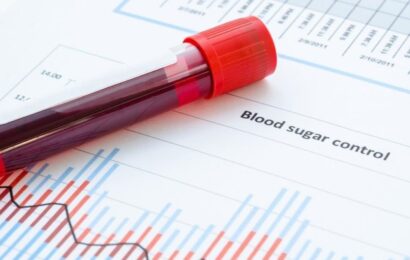This article is part three of a four-part series on blood glucose self-monitoring. The second installment, “Part 2: Monitoring Technique,” can be found here.
If you checked your blood glucose level two hours after lunch, and it clocked in at 287 mg/dl, what could you tell me about the effect of your lunch on your glucose level?
Absolutely nothing.
You don’t know anything about the effect of the meal because you don’t know what your blood glucose level was before the meal. Sure, most people would agree that 287 mg/dl is above target for an after-meal glucose reading, but this single number by itself is highly uninformative. It has no context. If your glucose reading had been 114 mg/dl before the meal, then of course you would know that either your choice of foods or your mealtime diabetes treatment is in serious need of adjustment.
But what if you were at 250 mg/dl before lunch? In that case, your blood glucose level rose by only 37 “points.” There was nothing wrong with the meal. Sure, there’s a problem that needs to be fixed, but it has nothing to do with lunch.
As this example demonstrates, isolated blood glucose checks are next to meaningless; they don’t tell you anything about how you got to where you are. “Smart” monitoring, on the other hand, does, because it follows a pattern. And the most basic pattern is monitoring before and after an event or activity.
Testing in pairs
The term “testing in pairs” was coined by Bill Polonsky, PhD, CDCES, of the Behavioral Diabetes Institute in San Diego. A pair is a set of blood glucose readings taken at bedtime and the next morning, before and after a meal, or before and after exercise, to give a few examples. By monitoring in pairs, each number gives context to the other. Instead of two meaningless data points, the two readings work together to tell a story.
Bedtime and morning readings mainly tell you the story of what happened in your sleep. Did your blood glucose rise between bedtime and morning? If so, it is likely that your liver is dumping excess glucose into your system while you sleep. (Other possibilities include the Somogyi effect, in which the body responds to low blood glucose by raising it, and the dawn phenomenon, in which the body releases certain hormones in the early morning that cause the blood glucose level to rise.) Your doctor can fix nighttime problems by adjusting your drug or insulin regimen – but not if he or she doesn’t know about them. If you don’t monitor and then report your results, any problems are likely to go unresolved.
Monitoring around meals tells two different stories: First, your reading before a meal is a reflection of the period leading up to the meal. If your glucose level is above target before a meal, your basal, or baseline, therapy for your fasting state might need to be adjusted; or the previous meal may have thrown you out of whack. Second, the change between your premeal reading and its postmeal partner in the pair is the measure by which you can judge the impact of the meal and how successfully the meal and your therapy are matched to each other.
The only situation in which an isolated blood glucose reading has value is to either confirm or rule out hypoglycemia (low blood glucose). If you feel “low,” you should check with your meter to confirm that what you’re feeling is real and to determine how dangerous your situation is. But even in this circumstance, a pair has value: After treating your hypoglycemia, you should check your blood glucose again to ensure that the crisis has been averted and to judge how effective your intervention was. If your blood glucose level shoots up later in the day, you probably overtreated the hypoglycemia, and this is good information to have for your next low.
How often should you check?
How many pairs of blood glucose checks you deploy in a day likely has more to do with your health insurance coverage than with your specific health situation – and it may be fewer than you ideally “should” do. Insurance plans are notoriously stingy when it comes to covering blood glucose test strips, a position that is based on a wrong interpretation of medical guidelines.
For a number of years, the standards of care for diabetes from the American Diabetes Association (ADA), which are the guidelines under which most people in the United States receive treatment (other specialty medical associations, such as the American Association of Clinical Endocrinologists [AACE], offer competing guidelines), stated that people taking only oral drugs should monitor at least once a day, and that those taking insulin should monitor at least three times a day. Somehow, both the Centers for Medicare and Medicaid Services (CMS), and then commercial health insurance plans, latched onto this guideline while ignoring the “at least” part of each sentence. So for many years, the default number of strips covered by insurance was a woefully sparse one or three per day, depending on a person’s type of therapy. True, most doctors could eke some more strips out of health plans, but it was a bit like wringing water from a stone, and it took a lot of unreimbursed time and paperwork to make it happen.
In January 2013, however, the ADA strongly clarified its intent, saying that anyone who uses an insulin pump or takes multiple daily insulin injections “should do SMBG [self-monitoring of blood glucose] at least prior to meals and snacks, occasionally postprandially [after meals], at bedtime, prior to exercise, when they suspect low blood glucose, after treating low blood glucose until they are normoglycemic, and prior to critical tasks such as driving.” The ADA went on to spell out what this means in terms of coverage: “For many patients, this will require testing 6–8 times daily, although individual needs may be greater.” It will take some time, unfortunately, for these new guidelines to take hold among insurance companies.
On the subject of people with type 2 diabetes who take only oral drugs, the ADA declined to recommend a set number of glucose checks in its new guidelines, saying instead: “The frequency and timing of SMBG should be dictated by the particular needs and goals of the patient.” Later, in the fall of 2013, the AACE muddied the waters further by questioning whether people with type 2 diabetes on some oral drugs need to be monitoring at all. I think we need to take a quick detour on this topic.
I think all people with diabetes should monitor their blood glucose levels, and I have seen clinically that monitoring can benefit anyone with diabetes. That said, the research on whether monitoring benefits certain people — particularly those with type 2 diabetes who don’t take insulin — is conflicting.
Why is that?
Well, I can see how monitoring might do little good if a person were simply handed a meter with minimal instructions regarding how, when, where and why to use it. On the other hand, a person empowered by knowledge who has the right tools is a well-equipped warrior, because diabetes is at least 50% a social disease. How you eat, move and act has a large impact on your blood glucose levels, and monitoring is a tool that tells you how and when you should be doing these things.
If those of us with diabetes were to rely on the quarterly HbA1c test (a measure of blood glucose control over two to three months) instead of self-monitoring to evaluate our blood glucose control, we would risk kidding ourselves about the quality of our blood glucose control. Not all HbA1c results are created equal, even if they appear to be exactly the same, since the test is a reflection of average blood glucose level. So, for example, you can get an average of 150 from a set of numbers that ranges from 125 to 175, but you can get the same average from a set that ranges from 75 to 225. Given what we are learning about the relationship between glucose variability and diabetes complications, it’s clear that it’s important to not only maintain a certain average blood glucose level, but also to keep the range of numbers as small and as stable as possible. Without the real-time feedback of a meter to inform you of the relationship between your actions and your glucose readings, true diabetes control is impossible.
So setting aside concerns about insurance and cost for the moment, is there an optimal monitoring schedule? Yes, but it’s not the same for every person (or for each type of diabetes, for that matter). The more complex your therapy is, the more variables there are, and therefore the more often you should monitor. People who take three oral drugs should monitor more often than those who take only one. All people who take insulin should monitor more often than those who take oral drugs. And people who take fast-acting insulin should monitor more often than those who take only basal insulin.
Another consideration is that some people, whether they have type 1 or type 2 diabetes, just seem to have more stable overall blood glucose patterns, while other people seem to have inherently unstable glucose levels or to be hypersensitive to the environmental factors that affect those levels. Lifestyle, the driving force behind the social factors that determine 50% of diabetes control, should also be considered when it comes to monitoring. Shift workers with irregular hours, for instance, tend to have more unstable blood glucose patterns than people who work regular hours. The same is true for people with diabetes who work in high-stress jobs.
Test-strip strategies
Of course, in the real world, money- and insurance-related concerns can’t be set aside. For the foreseeable future, many people with diabetes will have to make do with far fewer than the optimal number of test strips. So what are your options if your supply of strips is limited?
Random pairs.
You can’t monitor in pairs if you only have one strip for each day, right? Wrong. You just have to be content with monitoring every other day. For example, you could monitor before and after lunch every other day for a week. (You never want to draw any conclusions or make changes based on a single pair.) Next, you could examine your nights for a few days, monitoring at bedtime and in the morning. After that, maybe you could check before and after your three-times-a-week workout. This approach means examining your daily routine piece by piece, but it can still be quite effective.
Burst testing.
Another way to study how your life interacts with your diabetes — when you can’t do this with multiple daily glucose checks — is to take a page from statistics. Statistics can help us study almost any situation in which looking at all the data points is simply impossible. One fundamental tenet of statistics is that a properly taken sample can stand in for a larger whole. For example, one of the most common uses of statistical sampling in society today is an opinion poll. If you ask a large enough sample of people what they think of Congress, you can conclude from their answers what the entire population thinks about Congress. Of course, for this to work, the sample has to be representative of the population. If you asked only Republicans in Vermont what they thought of Congress, their answers would be interesting and valid for that population, but they would tell you nothing about what the entire country thinks.
The same is true for taking statistical samples of blood glucose levels: The strongest sample is one that represents the entire population. In this case, the population is not the American public, but rather every single day that you manage your diabetes. To sample a day realistically takes eight strips: a pair for the night and a pair for each meal. So how can you do this if your health insurance plan limits you to one strip per day?
The answer is called burst testing, and it involves saving up your strips for a month before deploying them in a brief but intense burst of monitoring, and then using this sample of days to project what’s happening during the rest of the month. Bursts are commonly done for three days. Eight tests a day for three days uses up 24 strips. If you’re stuck with the classic one strip per day for people who don’t take insulin, you’ll still have six or seven strips left over each month for emergencies.
I both love and hate burst testing. I worry about the fact that it leaves people with diabetes without information and exposed to potential danger for 27 or 28 days out of the month. But at the same time, I realize that it provides better information about blood glucose control than either once-a-day monitoring or random pairs. If you decide to try burst testing, be sure to choose a span of days that includes one weekend day, as our weekday and weekend days tend to have a different ebb and flow to them (and often a difference in eating patterns, as well).
When “bad” numbers happen
It’s critical to remember two things when looking at your numbers, especially the ones around meals. The first is that you should focus less on altitude and more on spread. Put simply: Don’t look so much at what the numbers are, but rather at the differences between them. The second thing to remember is that there’s no such thing as a bad number.
“Bad” numbers are just good information. Too often, when our numbers don’t fit into the desired range, we think of them in a negative way. They are bad numbers. We are doing a bad job. We are bad people.
Don’t let yourself go down this road. Instead, celebrate an elevated number (or a below-target one, for that matter). You just discovered a problem that can be fixed! This is a victory. That high or low number would have been there whether or not you discovered it, and by finding the number through monitoring, you can now do something about it. The only truly bad number is an out-of-range one that you are unaware of.
The goals of monitoring
Smart monitoring is monitoring that helps you understand your diabetes, your body and your therapy. This understanding allows you and your healthcare providers to evaluate your current therapy and lifestyle, and to make changes if necessary.
If your blood glucose is not where it should be, it needs to be fixed. Sometimes you can fix it yourself. Insulin users — especially those who take fast-acting insulin — are especially fortunate to be able to make ongoing therapy adjustments on their own. And, of course, all of us have the power to make adjustments in what and how much we eat and in how we move.
Sometimes, though, blood glucose problems are beyond our ability to fix on our own. Diabetes is a progressive disease, and our bodies can adapt to many drugs and therapies so that they lose their effectiveness over time. If you’ve done all you can and your blood glucose is still too high, you’ve most likely outgrown your therapy, and you’ll need your doctor’s assistance to devise a new strategy.
Without smart monitoring, neither you nor your doctor will know enough about your diabetes to evaluate your treatment in a meaningful way or to change it thoughtfully if needed. Smart monitoring can give you an early warning when things aren’t going as planned, and it can help keep you on track when it comes to the 50% of your diabetes control that’s social in nature.
Of course any kind of smart monitoring — pairs, random pairs or burst testing — requires you to make sense of the readings you get. With that purpose in mind, there is one more tool we need to talk about: the humble logbook. Stay tuned for Part 4, which will take this on. Until then, click here for some blood glucose self-monitoring field tips.
Want to learn more about managing blood sugar? Read “What Is a Normal Blood Sugar Level?” “Managing Your Blood Glucose Ups and Downs”, and “Making Your Blood Glucose Monitor Work for You,” then see our blood sugar chart.




